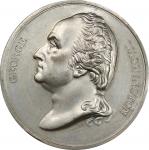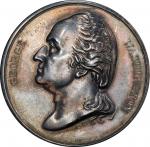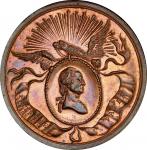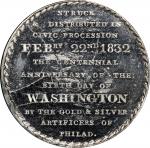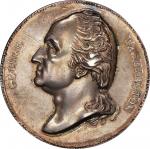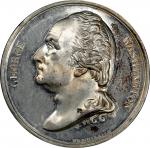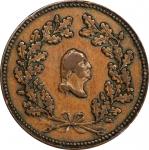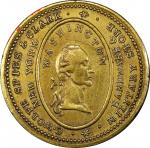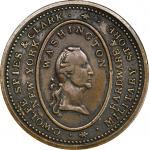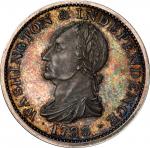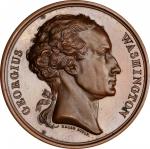Circa 1849 Birth Centennial / Award Medal Prototype by C.C. Wright and James Bale. Struck from the original reverse. Musante GW-127, Baker-74B. Silver. AU-55 (PCGS).44.9 mm. 4.2 to 4.8 mm thick at the rims. 1074.8 grains. A fascinating silver medal by Wright and Bale. The obverse is deeply toned dark gray, verging on slate, with scattered spots of silver brilliance dotting the obverse. Traces of gentle golden brown are also noted. The reverse is lighter pearl gray with subtle accents of blue iridescence in the recesses. A few minor marks, scuffs and hairlines are seen on both sides but none is bothersome.<p>This thick and impressive striking from the original reverse die is the third in the sequence of the three medals offered here. When it sold in the Bushnell sale in 1882, it was described as "same wreath; struck before the die was lettered." This seems obvious until close study reveals otherwise. The die break described above is the first clue. On this piece it is in the late state, and notably, partly chased away. The late state verifies the sequence, but raises the question as to what became of the reverse lettering. It also illustrates that the maker (most likely) was aware of this break and bothered enough by it to attempt to weaken its presentation on this medal. This is almost certainly the flaw that rendered the die unfit for further use.<p>As to the missing lettering, it was hand-chased off of this medal, post-striking. This was very well accomplished and though some slight evidence of the tooling can be detected once one knows to look for it, it is anything but obvious. Some might even question it, but one tiny artifact was overlooked which guarantees that this is what occurred. Finishing the second to last line in the legend is "1799." That final period is nestled into the curve of the adjacent oak leaf and was left behind when the remaining legend was removed.<p>In addition to the above work, a plug is inserted into the edge at 12:00, and appears contemporary to the production of the medal. Most likely an integral hanger was added, then the idea abandoned. It would appear that the intent was to repurpose this piece as an award medal of some type. As such, this is probably the prototype for what would become the Brooklyn Institute Award medals. The fact that at least one of those, per Musante, was fashioned from a bust "cut from an existing medal and fused onto a silver blank, the engraved rim detail added," demonstrates that Wright engaged in such experimentation as seen here and in the lot above.Ex Charles I. Bushnell, S.H. and H. Chapman, June 1882, lot 1338; William Spohn Baker Collection, to the Historical Society of Pennsylvania by bequest, November 15, 1897.


